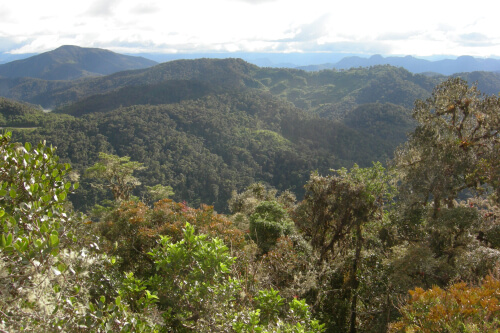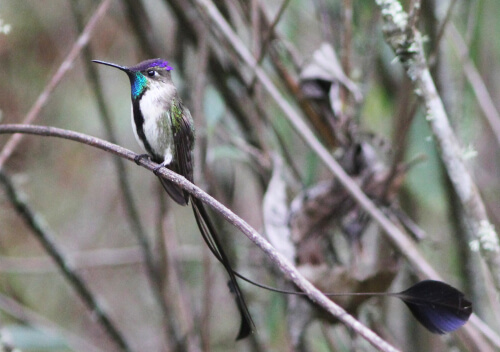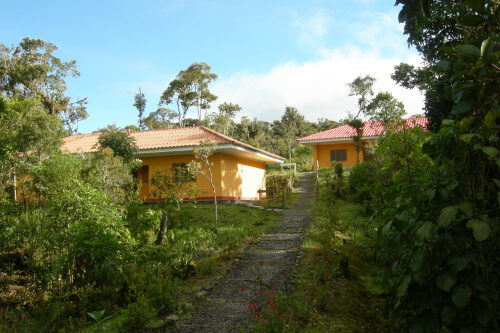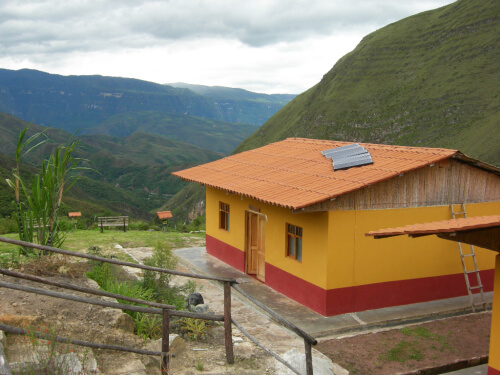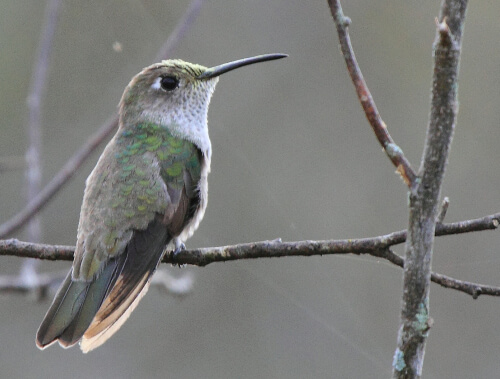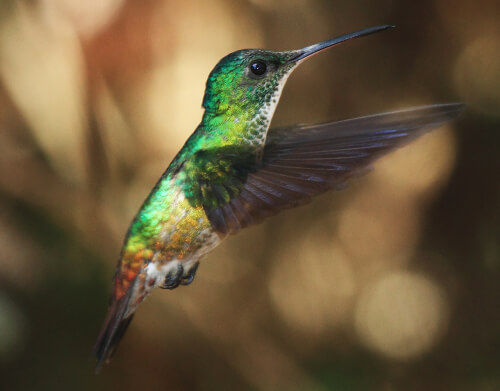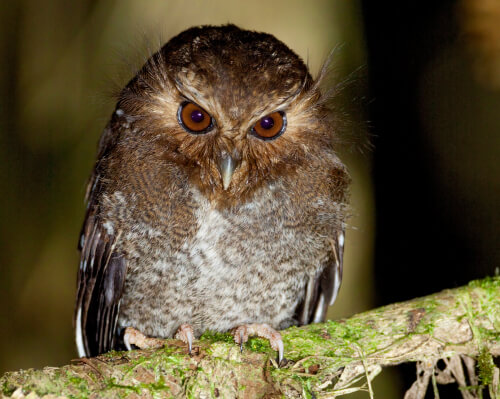Return to Abra Patricia: A Culture of Peruvian Conservation is Spreading
By Daniel Lebbin
My first visit to Abra Patricia in northern Peru was ten years ago in November of 2004, as a grad student traveling with two buddies. We explored the area in a rented Isuzu Rodeo, which we drove from the Pacific coast across the Andes on one of the few paved highways.
This area is well known to birdwatchers as one of the premier birding areas in Peru. Here mist-enshrouded cloud forests grow alongside the highway and are home to mysterious orchids, Andean bears, and the critically endangered yellow-tailed woolly monkey. Among birders, Abra Patricia is particularly famous for its many endemic and enigmatic species such as the Long-whiskered Owlet, Ochre-fronted Antpitta, Johnson's Tody-Flycatcher, Royal Sunangel, and Bar-winged Wood-Wren.
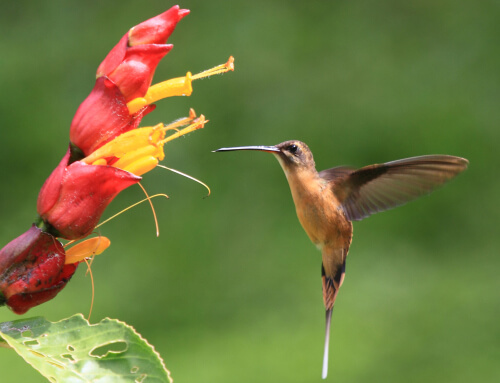
Koepcke's Hermit near Tarapoto. Photo by Fábio Olmos
We spent all day birdwatching, hiking deep into the forests and up steep slopes covered in bamboo and gnarled trees. We slept on covered porches and in potato lofts of the shanties belonging to local campesinos, or at a hotel in the town of Pomacochas about an hour drive away. Sweaty, dirty, and rained-upon, we saw a ton of birds and loved every moment of it.
At that time, Abra Patricia was largely an unprotected frontier, with a few hardscrabble colonists from elsewhere in the Andes living in the area, but pressures were building and threatened the forests of the region, which were experiencing some of the greatest population growth and deforestation rates in Peru.
Protecting Abra Patricia
The next year in 2005, Asociación Ecosistemas Andinos (ECOAN) began purchasing land to establish a reserve at Abra Patricia with support from American Bird Conservancy. The same year, ECOAN also worked with the community of Pomacochas to create the Huembo reserve for the Marvelous Spatuletail hummingbird.
In the years since, ECOAN and ABC continued to work together to build a world-class reserve protecting more than 25,000 acres at Abra Patricia and expanded Huembo to 113 acres. We also worked with surrounding communities to plant roughly a million trees and coffee bushes to restore habitat on degraded lands for resident and migratory birds.
To provide income to the reserves at Huembo and Abra Patricia, ABC supported ECOAN to build a lodge and research center at Abra Patricia as well as a visitor center at Huembo. ECOAN hired and trained local people to work as park guards, establish tree nurseries, run a reforestation campaign with local communities, and become skilled in guiding birdwatchers.
With support from Conservation International, ECOAN began working with colonist communities within the neighboring Alto Mayo Protection Forest to implement conservation actions and forest restoration. ECOAN continues to work with regional and local government authorities to establish new protected areas for conservation. Now, other groups and individuals are following ECOAN's lead by developing additional protected areas, managing land for conservation, and promoting tourism for birders.
I graduated in 2007 and started working at ABC in 2008, transitioning to the International team and supervising this project in 2010. This gave me the opportunity to return to Abra Patricia to supervise projects or guide trips for ABC supporters. In April 2014, I returned to Abra Patricia after an absence of almost two years since my last visit in November of 2012.
I was amazed at some of the positive changes I saw. The reserve still faces challenges, but returning after two years to see it functioning better than ever and visit properties acquired in 2013 was extremely rewarding. The tremendous conservation effort of ECOAN and ABC here is succeeding. ABC's supporters can be very proud of the advances made here in northern Peru. And not only are the conservation efforts of ECOAN and ABC working at Abra Patricia, but the culture of Peruvian conservation that ECOAN had planted in the area is spreading.
Spreading a Culture of Peruvian Conservation
Starting at the edges of Abra Patricia Reserve, two properties adjacent to the reserve were recent purchases by conservation-minded parties. A French couple bought property on the western side of the reserve and planted native trees purchased from ECOAN-established nurseries. Along with the land belonging to ECOAN, this land protects the water supply of ECOAN's lodge and the 70 inhabitants of the nearby village of Vista Alegre. Another property on the eastern side of the reserve, now called Fondo Alto Nieva, was purchased by a Peruvian tour guide who is managing the land for conservation. Having worked previously with ECOAN, his staff built facilities to accommodate tents for backpackers and established a hummingbird feeding station. Many of the visitors who come for an hour or two to enjoy the hummingbird feeders arrive from ECOAN's lodge, where they spend the night.
It seems that hummingbird feeding, tourism, and conservation culture has spread much farther than Abra Patricia, thanks again to ECOAN and people trained by ECOAN. ECOAN has helped the Alto Mayo Protection Forest authorities and inhabitants put up new signs at good birdwatching sites. About two hours east of Abra Patricia, near the city of Moyobamba, the Altomirano family established an orchid garden and hummingbird feeding station called Waqanki along the Mishquiyacu creek.
Nearby Waqanki, a couple operates a hotel and restaurant and also implemented hummingbird feeders inspired by ECOAN. Many of these hummingbird feeders are locally constructed out of recycled soda bottles by a man named Billclinton (one word), who was trained by ECOAN. When another group located east of Tarapoto wanted to create a hummingbird feeding station particularly for Koepcke's Hermit, they contracted Billclinton.
Far to the east of Abra Patricia, ECOAN also worked with the Troyes family to establish conservation areas, tourism, and hummingbird feeders at Gotas de Agua in the Marañon Valley. Finally, ECOAN has been training and mentoring a local birding guide from Tarapoto to conduct bird monitoring, who recently purchased a property to conserve dry forests and birds he loves near the Huallaga River.
(If you like hummingbirds, you can see 40-50 species thanks to the five hummingbird feeding stations now established by ECOAN and others between Tarapoto and Huembo.)
Continuing the Conservation Tradition
ECOAN is not resting on its conservation laurels, however, and we expect more successes in the future. ECOAN is working on a deal to sell carbon sequestration services, which would help pay for many management activities to protect the reserve's forests. As part of this activity, Tino Aucca, ECOAN's President, has been working to create additional Regional Conservation Areas that are even bigger than Abra Patricia in the region of Amazonas to achieve the scale needed by carbon investors.
The reserve staff are well-trained and continuing to make improvements to the reserve including improving existing trails and expanding the trail system which may offer additional spots to see rare birds close to the lodge in the future. Additionally, ECOAN is beginning to experiment with nest boxes for the Long-whiskered Owlet.
There are several ways you can help contribute to ECOAN's conservation work in northern Peru. First, if you have never been, plan a trip to visit Owlet Lodge at Abra Patricia, or if you have already been, consider coming back to enjoy new trails and other advances. More information about visiting can be found at the Owlet Lodge website and Conservation Birding.
Owlet Lodge is also an eBird hotspot, as are other portions of the Abra Patricia reserve. Researchers are encouraged to consider conducting a project at Abra Patricia and to stay at the research center. All revenues from tourism and research are used to support ECOAN and reserve operations.
Note: The work at Abra Patricia and surrounding areas was made possible by the generous support of IUCN NL, The Gordon and Betty Moore Foundation, The Jeniam Foundation, Gulf Coast Bird Observatory's Tropical Forest Forever Fund, Connie & Jeff Woodman, Patricia & David Davidson, Cathy & Warren Cooke, Nancy & Dick Eales, David Harrison, the Robert Wilson Charitable Trust, and the USFWS through the Neotropical Migratory Bird Conservation Act and Wildlife Without Borders Latin American and Caribbean programs.
 Daniel Lebbin works in ABC's International Division, leading projects in Peru, Bolivia, and Chile to create and expand nature reserves for the hemisphere's rarest birds. Dan co-authored The American Bird Conservancy Guide to Bird Conservation published in 2010. He received his Ph.D. from Cornell University, where he studied habitat specialization of Amazonian birds and spent a year as a Fulbright scholar in Peru.
Daniel Lebbin works in ABC's International Division, leading projects in Peru, Bolivia, and Chile to create and expand nature reserves for the hemisphere's rarest birds. Dan co-authored The American Bird Conservancy Guide to Bird Conservation published in 2010. He received his Ph.D. from Cornell University, where he studied habitat specialization of Amazonian birds and spent a year as a Fulbright scholar in Peru.





































